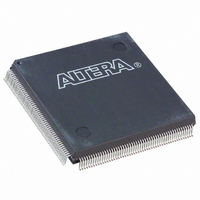EPF10K10QC208-4N Altera, EPF10K10QC208-4N Datasheet - Page 17

EPF10K10QC208-4N
Manufacturer Part Number
EPF10K10QC208-4N
Description
IC FLEX 10K FPGA 10K 208-PQFP
Manufacturer
Altera
Series
FLEX-10K®r
Datasheet
1.EPF10K10ATC100-3.pdf
(128 pages)
Specifications of EPF10K10QC208-4N
Number Of Logic Elements/cells
576
Number Of Labs/clbs
72
Total Ram Bits
6144
Number Of I /o
134
Number Of Gates
31000
Voltage - Supply
4.75 V ~ 5.25 V
Mounting Type
Surface Mount
Operating Temperature
0°C ~ 85°C
Package / Case
208-MQFP, 208-PQFP
Family Name
FLEX 10K
Number Of Usable Gates
10000
Number Of Logic Blocks/elements
576
# I/os (max)
134
Frequency (max)
125MHz
Process Technology
CMOS
Operating Supply Voltage (typ)
5V
Logic Cells
576
Ram Bits
6144
Device System Gates
31000
Operating Supply Voltage (min)
4.75V
Operating Supply Voltage (max)
5.25V
Operating Temp Range
0C to 70C
Operating Temperature Classification
Commercial
Mounting
Surface Mount
Pin Count
208
Package Type
PQFP
Lead Free Status / RoHS Status
Lead free / RoHS Compliant
Other names
544-2197
Available stocks
Company
Part Number
Manufacturer
Quantity
Price
Company:
Part Number:
EPF10K10QC208-4N
Manufacturer:
ALTERA20
Quantity:
144
Altera Corporation
Figure 8. Cascade Chain Operation
d[(4 n -1)..(4 n -4)]
AND Cascade Chain
d[3..0]
d[7..4]
LUT
LUT
LUT
Cascade Chain
With the cascade chain, the FLEX 10K architecture can implement
functions that have a very wide fan-in. Adjacent LUTs can be used to
compute portions of the function in parallel; the cascade chain serially
connects the intermediate values. The cascade chain can use a logical AND
or logical OR (via De Morgan’s inversion) to connect the outputs of
adjacent LEs. Each additional LE provides four more inputs to the
effective width of a function, with a delay as low as 0.7 ns per LE. Cascade
chain logic can be created automatically by the Compiler during design
processing, or manually by the designer during design entry.
Cascade chains longer than eight bits are implemented automatically by
linking several LABs together. For easier routing, a long cascade chain
skips every other LAB in a row. A cascade chain longer than one LAB
skips either from even-numbered LAB to even-numbered LAB, or from
odd-numbered LAB to odd-numbered LAB (e.g., the last LE of the first
LAB in a row cascades to the first LE of the third LAB). The cascade chain
does not cross the center of the row (e.g., in the EPF10K50 device, the
cascade chain stops at the eighteenth LAB and a new one begins at the
nineteenth LAB). This break is due to the EAB’s placement in the middle
of the row.
Figure 8
functions with a wide fan-in. These examples show functions of 4n
variables implemented with n LEs. The LE delay is as low as 1.6 ns; the
cascade chain delay is as low as 0.7 ns. With the cascade chain, 3.7 ns is
needed to decode a 16-bit address.
FLEX 10K Embedded Programmable Logic Device Family Data Sheet
shows how the cascade function can connect adjacent LEs to form
LE n
LE1
LE2
d[(4 n -1)..(4 n -4)]
OR Cascade Chain
d[3..0]
d[7..4]
LUT
LUT
LUT
LE n
LE1
LE2
17














